| 2006
Videos: Ocean Explorer Return to the Mariana Arc The edited video clips show highlights from Brimstone Pit dives with the JASON II remotely operated vehicle. These movies are larger format versions (480 x 360) of the video clips available on the NOAA Ocean Exploration web site, along with images and logs from the expedition. |
||
NW Rota 1-Brimstone
Pit Eruption Videos |
||
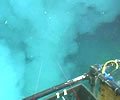 |
During
the first dive at NW Rota-1 volcano, a huge eruption plume covered
the entire summit of the volcano and every time Jason approached the
bottom it was caught in a white out. Apparently a major eruptive burst
had just occurred. We were not able to approach Brimstone Pit until
the following day when the smoke had cleared. |
|
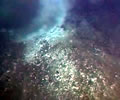 |
Jason
II approaches Brimstone Pit for the first time during our 2006 expedition
and finds that the south flank of the cone has completely fallen away.
Only a remnant of the north wall remains. At first not much is happening
at the vent, but gradually a degassing event starts releasing a huge
number of bubbles (probably CO2). Quicktime:20.7 MB | Windows Media: 7.8 MB |
|
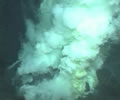 |
Five
hours later, Jason II returns to Brimstone Pit to find that lava has
been extruded from the vent and it is degassing intensely. Quicktime:20.6 MB | Windows Media: 7.5 MB |
|
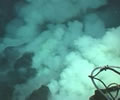 |
Jason
II finds gas bubbles emitting directly from a fresh lava rock that
we think was recently erupted from the Brimstone vent. During our
visit the output of gases varied dramatically by the minute. Quicktime:18.5 MB | Windows Media: 7.0 MB |
|
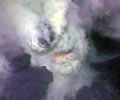 |
This
appears to be lava in the act of erupting from Brimstone Pit. It is
not glowing red, like in Hawaii, because this lava is more viscous
- it is coming out very slowly and immediately forms a crust. But
it is clearly degassing intensely, and small pieces of lava are spalling
off as it expands. This looks very similar to the view when lava enters
the ocean on the coast of Hawaii, even though the process is quite
different here (and we are 560 meter underwater!). Quicktime:19.2 MB | Windows Media: 7.1 MB |
|
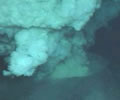 |
When
we returned to Brimstone Pit during Jason dive J2-189, we encountered
a very dynamic and constantly changing site. We visited the site several
times during the dive, and each time we saw a different style of activity.
At first, we found that mild explosive activity at the vent was building
a new cone of ash and rocks around the vent. Quicktime:21.9 MB | Windows Media: 8.1 MB |
|
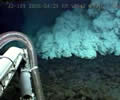 |
Later
during Jason dive J2-189, while the pilots were trying to tend to
a troublesome suction sampler, a large burst from Brimstone Pit (which
clearly has two side-by-side eruptive vents) almost engulfs the vehicle
in an ash plume. Quicktime:21.3 MB | Windows Media: 8.2 MB |
|
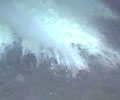 |
Later,
when Jason visited Brimstone again we found what we think were think
lava flows that had overflowed the vent and flowed down the sides
a short distance. The lava flows are degassing intensely with a combination
of white sulfurous smoke and CO2 bubbles. Quicktime:16.9 MB | Windows Media: 6.8 MB |
|
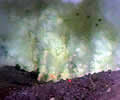 |
Still
later, Brimstone Pit turned into a fireworks show with exploding rocks,
bright yellow clouds jetting upward filled with droplets of molten
sulfur, and thick streams of gas bubbles. Quicktime:20.8 MB | Windows Media: 7.8 MB |
|
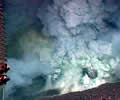 |
At
the very end of Jason dive J2-189, we witnessed the most violent eruptions
we have seen so far from Brimstone Pit. The spectacle is simply jaw
dropping! Quicktime:20.4 MB | Windows Media: 7.8 MB |
|
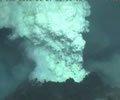 |
Eruptive
activity waxed and waned during the time that Jason II was making
visual observations at Brimstone Pit. Quicktime:18.9 MB |
|
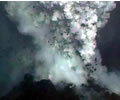 |
Jason
II was able to make extended observations at Brimstone Pit during
dive J2-192. The science team witnessed repeated pulses of lava rising
in the vent that were initially crusted over but would quickly crack
open and expel their molten contents. Violently expanding volcanic
gases break apart and propel pieces of the lava crust in all directions. Quicktime:21.1 MB | Windows Media: 8.0 MB |
|
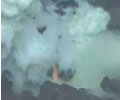 |
This
is the first time that glowing lava has ever been witnessed from a
submarine volcanic eruption! In this case, the lava is rising in the
vent so fast that a small glimpse of red glow can be seen intermittently
before it crusts over or is blown apart. What a sight! Do you think
the scientists were a little excited? Voice-Quicktime:26.5 MB | Windows Media: 8.22 MB; Hydrophone- 26.5 MB | Windows Media: 8.22 MB |
|
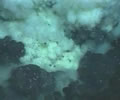 |
During eruptive pulses, the edge of the volcanic plume expanded and
contracted very rapidly - almost vibrating - probably due to steam
forming and condensing rhythmically around the hot erupting lava. Quicktime:21.2 MB | Windows Media: 8.3 MB |
|
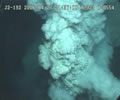 |
This
is the largest explosive burst that we saw at Brimstone Pit during
Jason dive J2-192. There were probably even larger bursts that we
were not able to see, at times when the eruption plume was so extensive
and thick that we could not get near the vent. Voice-Quicktime:34.2 MB | Windows Media: 13.0 MB Hydrophone-Quicktime: 34.2 MB | Windows Media: 8.22 MB |
|
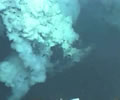 |
At
times, the eruptive vent at Brimstone Pit was pulsing so much from
the rising lava and expanding gases that it looked like a seething
caldron! Quicktime:19.5 MB | Windows Media: 7.7 MB |
|
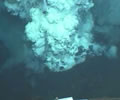 |
Chief
Scientist Bob Embley summarizes our observations of eruptive activity
at Brimstone Pit Quicktime:14.8 MB |
|
